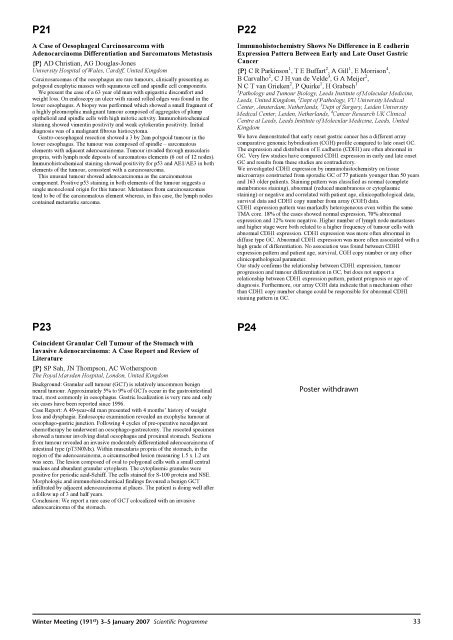2007 Winter Meeting - London - The Pathological Society of Great ...
2007 Winter Meeting - London - The Pathological Society of Great ...
2007 Winter Meeting - London - The Pathological Society of Great ...
- No tags were found...
Create successful ePaper yourself
Turn your PDF publications into a flip-book with our unique Google optimized e-Paper software.
P21A Case <strong>of</strong> Oesophageal Carcinosarcoma withAdenocarcinoma Differentiation and Sarcomatous Metastasis{P} AD Christian, AG Douglas-JonesUniversity Hospital <strong>of</strong> Wales, Cardiff, United KingdomCarcinosarcomas <strong>of</strong> the oesophagus are rare tumours, clinically presenting aspolypoid exophytic masses with squamous cell and spindle cell components.We present the case <strong>of</strong> a 63 year old man with epigastric discomfort andweight loss. On endoscopy an ulcer with raised rolled edges was found in thelower oesophagus. A biopsy was performed which showed a small fragment <strong>of</strong>a highly pleomorphic malignant tumour composed <strong>of</strong> aggregates <strong>of</strong> plumpepithelioid and spindle cells with high mitotic activity. Immunohistochemicalstaining showed vimentin positivity and weak cytokeratin positivity. Initialdiagnosis was <strong>of</strong> a malignant fibrous histiocytoma.Gastro-oesophageal resection showed a 3 by 2cm polypoid tumour in thelower oesophagus. <strong>The</strong> tumour was composed <strong>of</strong> spindle – sarcomatouselements with adjacent adenocarcinoma. Tumour invaded through muscularispropria, with lymph node deposits <strong>of</strong> sarcomatous elements (6 out <strong>of</strong> 12 nodes).Immunohistochemical staining showed positivity for p53 and AE1/AE3 in bothelements <strong>of</strong> the tumour, consistent with a carcinosarcoma.This unusual tumour showed adenocarcinoma as the carcinomatouscomponent. Positive p53 staining in both elements <strong>of</strong> the tumour suggests asingle monoclonal origin for this tumour. Metastases from carcinosarcomastend to be <strong>of</strong> the carcinomatous element whereas, in this case, the lymph nodescontained metastatic sarcoma.P22Immunohistochemistry Shows No Difference in E cadherinExpression Pattern Between Early and Late Onset GastricCancer{P} C R Parkinson 1 ,TEBuffart 2 , A Gill 1 , E Morrison 4 ,B Carvalho 2 , C J H van de Velde 3 ,GAMeijer 2 ,N C T van Grieken 2 , P Quirke 1 , H Grabsch 11 Pathology and Tumour Biology, Leeds Institute <strong>of</strong> Molecular Medicine,Leeds, United Kingdom, 2 Dept <strong>of</strong> Pathology, VU University MedicalCenter, Amsterdam, Netherlands, 3 Dept <strong>of</strong> Surgery, Leiden UniversityMedical Center, Leiden, Netherlands, 4 Cancer Research UK ClinicalCentre at Leeds, Leeds Institute <strong>of</strong> Molecular Medicine, Leeds, UnitedKingdomWe have demonstrated that early onset gastric cancer has a different arraycomparative genomic hybridisation (CGH) pr<strong>of</strong>ile compared to late onset GC.<strong>The</strong> expression and distribution <strong>of</strong> E cadherin (CDH1) are <strong>of</strong>ten abnormal inGC. Very few studies have compared CDH1 expression in early and late onsetGC and results from these studies are contradictory.We investigated CDH1 expression by immunohistochemistry on tissuemicroarrays constructed from sporadic GC <strong>of</strong> 77 patients younger than 50 yearsand 163 older patients. Staining pattern was classified as normal (completemembranous staining), abnormal (reduced membranous or cytoplasmicstaining) or negative and correlated with patient age, clinicopathological data,survival data and CDH1 copy number from array (CGH) data.CDH1 expression pattern was markedly heterogeneous even within the sameTMA core. 18% <strong>of</strong> the cases showed normal expression, 70% abnormalexpression and 12% were negative. Higher number <strong>of</strong> lymph node metastasesand higher stage were both related to a higher frequency <strong>of</strong> tumour cells withabnormal CDH1 expression. CDH1 expression was more <strong>of</strong>ten abnormal indiffuse type GC. Abnormal CDH1 expression was more <strong>of</strong>ten associated with ahigh grade <strong>of</strong> differentiation. No association was found between CDH1expression pattern and patient age, survival, CGH copy number or any otherclinicopathological parameter.Our study confirms the relationship between CDH1 expression, tumourprogression and tumour differentiation in GC, but does not support arelationship between CDH1 expression pattern, patient prognosis or age <strong>of</strong>diagnosis. Furthermore, our array CGH data indicate that a mechanism otherthan CDH1 copy number change could be responsible for abnormal CDH1staining pattern in GC.P23Coincident Granular Cell Tumour <strong>of</strong> the Stomach withInvasive Adenocarcinoma: A Case Report and Review <strong>of</strong>Literature{P} SP Sah, JN Thompson, AC Wotherspoon<strong>The</strong> Royal Marsden Hospital, <strong>London</strong>, United KingdomBackground: Granular cell tumour (GCT) is relatively uncommon benignneural tumour. Approximately 5% to 9% <strong>of</strong> GCTs occur in the gastrointestinaltract, most commonly in oesophagus. Gastric localization is very rare and onlysix cases have been reported since 1996.Case Report: A 49-year-old man presented with 4 months’ history <strong>of</strong> weightloss and dysphagia. Endoscopic examination revealed an exophytic tumour atoesophago-gastric junction. Following 4 cycles <strong>of</strong> pre-operative neoadjuvantchemotherapy he underwent an oesophago-gastrectomy. <strong>The</strong> resected specimenshowed a tumour involving distal oesophagus and proximal stomach. Sectionsfrom tumour revealed an invasive moderately differentiated adenocarcinoma <strong>of</strong>intestinal type (pT3N0Mx). Within muscularis propria <strong>of</strong> the stomach, in theregion <strong>of</strong> the adenocarcinoma, a circumscribed lesion measuring 1.5 x 1.2 cmwas seen. <strong>The</strong> lesion composed <strong>of</strong> oval to polygonal cells with a small centralnucleus and abundant granular cytoplasm. <strong>The</strong> cytoplasmic granules werepositive for periodic acid-Schiff. <strong>The</strong> cells stained for S-100 protein and NSE.Morphologic and immunohistochemical findings favoured a benign GCTinfiltrated by adjacent adenocarcinoma at places. <strong>The</strong> patient is doing well aftera follow up <strong>of</strong> 3 and half years.Conclusion: We report a rare case <strong>of</strong> GCT colocalized with an invasiveadenocarcinoma <strong>of</strong> the stomach.P24Poster withdrawn<strong>Winter</strong> <strong>Meeting</strong> (191 st ) 3–5 January <strong>2007</strong> Scientific Programme33













